
Carcharhiniformes, the ground sharks, are the largest order of sharks, with over 270 species. They include a number of common types, such as catsharks, swellsharks, and the sandbar shark.
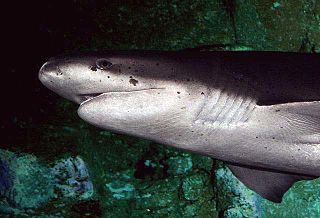
The Hexanchiformes are a primitive order of sharks, that numbering just seven extant species in two families. Fossil sharks that were apparently very similar to modern sevengill species are known from Jurassic specimens.
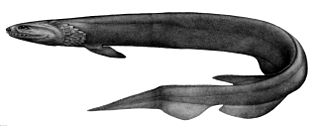
The frilled shark, also known as the lizard shark, is one of the two extant species of shark in the family Chlamydoselachidae. The frilled shark is considered a living fossil, because of its primitive, anguilliform (eel-like) physical traits, such as a dark-brown color, amphistyly, and a 2.0 m (6.6 ft)–long body, which has dorsal, pelvic, and anal fins located towards the tail. The common name, frilled shark, derives from the fringed appearance of the six pairs of gill slits at the shark's throat.

The Squaliformes are an order of sharks that includes about 126 species in seven families.

A sawshark or saw shark is a member of a shark order bearing a unique long, saw-like rostrum edged with sharp teeth, which they use to slash and disable their prey. There are eight species within the Pristiophoriformes, including the longnose or common sawshark, shortnose sawshark, Japanese sawshark, Bahamas sawshark, sixgill sawshark, African dwarf sawshark, Lana's sawshark and the tropical sawshark.

The angelsharks are a group of sharks in the genus Squatina of the family Squatinidae. They commonly inhabit sandy seabeds close to 150 m (490 ft) in depth. Many species are now classified as critically endangered by the International Union for Conservation of Nature. Once common over large areas of the Northeast Atlantic from Norway, Sweden, Morocco and the Canary Islands, to the Mediterranean and Black Seas, fishing pressure has resulted in significant population decline.
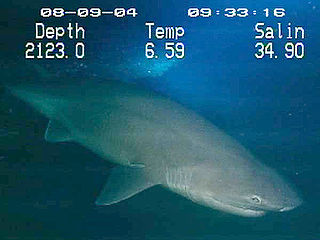
Cow sharks are a shark family, the Hexanchidae, characterized by an additional pair or pairs of gill slits. Its 37 species are placed within the 10 genera: Gladioserratus, Heptranchias, Hexanchus, Notidanodon, Notorynchus, Pachyhexanchus, Paraheptranchias, Pseudonotidanus, Welcommia, and Weltonia.

Elasmobranchii is a subclass of Chondrichthyes or cartilaginous fish, including sharks, rays, skates, and sawfish. Members of this subclass are characterised by having five to seven pairs of gill clefts opening individually to the exterior, rigid dorsal fins and small placoid scales on the skin. The teeth are in several series; the upper jaw is not fused to the cranium, and the lower jaw is articulated with the upper. The details of this jaw anatomy vary between species, and help distinguish the different elasmobranch clades. The pelvic fins in males are modified to create claspers for the transfer of sperm. There is no swim bladder; instead, these fish maintain buoyancy with large livers rich in oil.

Rajiformes is one of the four orders in the superorder Batoidea, flattened cartilaginous fishes related to sharks. Rajiforms are distinguished by the presence of greatly enlarged pectoral fins, which reach as far forward as the sides of the head, with a generally flattened body. The undulatory pectoral fin motion diagnostic to this taxon is known as rajiform locomotion. The eyes and spiracles are located on the upper surface of the head and the gill slits are on the underside of the body. Most species give birth to live young, although some lay eggs enclosed in a horny capsule.
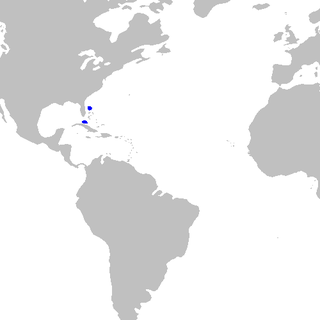
The Bahamas sawshark, Pristiophorus schroederi, is a sawshark of the family Pristiophoridae, found in the western Central Atlantic Ocean from the Bahamas and Cuba at depths of between 400 and 1,000 m. These sharks are at least 80 cm long.

Echinorhinus is the only extant genus in the family Echinorhinidae.

The longnose sawshark or common sawshark, is a sawshark of the family Pristiophoridae.

The sixgill sawshark, Pliotrema warreni is a sawshark of the family Pristiophoridae. Presence of 6 pairs of gill slits highlights this genus among sharks; outside Hexanchiformes order, Pliotrema is the only shark with more than 5 gill slits. Unlike other sawsharks, the barbs on this shark's rostrum continue onto the sides of the head. Its barbels are also closer to its mouth than in other species. At maximum, females can reach over 136 cm long, and males can reach over 112 cm long.
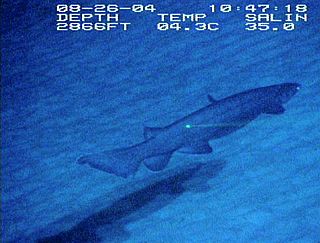
The southern African frilled shark is a species of shark in the family Chlamydoselachidae, described in 2009. It is found in the deep waters off southern Angola to southern Namibia. This species is difficult to distinguish from the better-known frilled shark, but is smaller at maturity and differs in several proportional measurements including head length and mouth width. It seems to be a specialized predator of smaller sharks, using its flexible jaws and numerous needle-like, recurved teeth to capture and swallow them whole. Reproduction is presumably aplacental viviparous, as with the other member of its family.
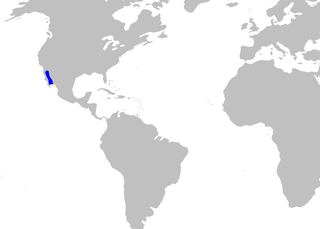
The peppered catshark is a common but little-known species of catshark, part of the family Scyliorhinidae, inhabiting depths of 130–1,326 m (427–4,350 ft) in the northern Gulf of California. It is found on or near the ocean floor, and conducts seasonal migrations, spending winter in deeper water. Reaching a length of 37 cm (15 in), this species has a slender grayish body with a fine covering of black dots. On the dorsal edge of its caudal fin is a prominent crest of enlarged dermal denticles. It is oviparous, with the reproductive period probably lasting from May to September. The International Union for Conservation of Nature (IUCN) has listed the peppered catshark under Least Concern, as it faces no significant threats from human activity.

The African sawtail catshark is a species of catshark, part of the family Scyliorhinidae. Demersal in nature, it is found at depths of 160–720 m (520–2,360 ft) off the western African coast from Morocco to South Africa. This slender species has a rather long, pointed snout, a series of dark saddles along the back and tail, and a prominent crest of enlarged dermal denticles along the upper edge of the caudal fin. Its maximum known length is 46 cm (18 in).

The Taiwan angelshark is an angelshark in the family Squatinidae. The Taiwan angelshark is one of four species of Squatina in the waters around Taiwan and Japan. It is a demersal, ray-like shark that grows to 1–2 meters in length.
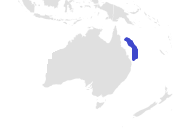
The tropical sawshark, Pristiophorus delicatus, is a recently described species of sawshark, family Pristiophoridae, formerly known in literature as Pristiophorus sp. B. It is endemic to northeastern Australia, found on the upper continental slope off Queensland from south of the Samaurez Reef, at a depth of 246–405 meters (807–1,329 ft). Its specific epithet delicatus is Latin for "delicate", referring to the fine teeth on its saw-like rostrum.
The Philippines angelshark is a species of angelshark, family Squatinidae, known only from a 33 cm (13 in) long immature female caught in the Philippines, where it is the only known representative of its family. It has a flattened body and head with greatly expanded pectoral and pelvic fins, and is greenish above with brown spots. Identifying traits of this species include the spiracles, which are more widely spaced than the eyes and bear papillae on the posterior inner rims, and the relative positions of the two dorsal fins. Additionally, S. caillieti lacks fringes on its barbels, enlarged thorns along the middle of its back, and ocelli ("eyespots") on its fins.

Galeomorphii is a superorder of cartilaginous fishes which includes all modern sharks except the dogfish and its relatives. They are sometimes called galea or galean sharks. There are about 300 living species in 23 families. Galean sharks are divided into four orders: the Heterodontiformes, Orectolobiformes, Lamniformes, and Carcharhiniformes. The extinct, enigmatic Synechodontiformes are presently placed by some authors in the galeomorphs, but their taxonomic position still remains uncertain.



















